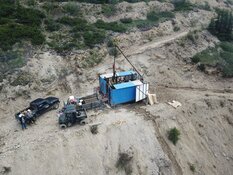The Gold Report: The U.S. dollar is worth about CA$1.20. In percentage terms, how is that translating to the margins of Canadian precious metals producers?
Philip Ker: Margins are obviously a function of revenues minus costs. Our model currently uses $1,250 per ounce ($1,250/oz) gold and a $0.90 or CA$1.11 exchange rate. This means we're forecasting CA$1,388/oz for Canadian producers, but a favorable strengthening of the U.S. dollar toward $1.25 or CA$0.80 would allow Canadian producers to realize gold prices around CA$1,560/oz—a 12.5% increase.
"Balmoral Resources Ltd.'s Grasset nickel discovery is on its way to becoming a world-class asset."
More recently, gold has risen alongside the U.S. dollar. Typically these two have a negative correlation but the opposite trend has provided a boost to many equities with Canada-based operations. In late January, a $1,300/oz gold price and CA$1.25 exchange rate meant a gold price in excess of CA$1,600/oz—a potential 17% increase to margins. For example, a low-cost gold producer like Lake Shore Gold Corp. (LSG:TSX), which is projecting all-in sustaining costs of US$950–1,000/oz, could see profit margins reach greater than CA$350/oz on 170,000–180,000 oz (170–180 Koz) of production. This is just remarkable leverage.
TGR: Are margins like those enough to revise your investment thesis for 2015?
PK: You can't build an entire investment thesis just on an exchange rate but some names will benefit more than others. Investors should always consider a company's assets, management and any political or operational risk that may exist.
TGR: Is the current U.S. dollar/Canadian dollar exchange rate sustainable?
PK: We should continue to see a stronger U.S. dollar in the near term, particularly with the Canadian economy's heavy exposure to oil. That sector has sold off considerably, thus putting negative pressure on the Canadian dollar.
TGR: The strong U.S. dollar is also helping companies with operations in Mexico. What are some companies you follow that are benefiting from a weaker peso?
PK: Timmins Gold Corp. (TMM:TSX; TGD:NYSE.MKT) and SilverCrest Mines Inc. (SVL:TSX; SVLC:NYSE.MKT) are two companies that come to mind. Timmins has been trimming costs at its San Francisco gold mine in Mexico at every corner possible over the past year. It has brought down cash costs to ~US$800/oz in order to offset the decreasing grades the company expects to experience in the coming years. Additionally, exploration costs across Mexico have dropped since a new tax regime was established last year and scaring off junior explorers from testing prospective ground. This makes negotiation of drilling contracts much easier as drillers and equipment become underutilized. This helps stretch exploration dollars much, much further and is more favorable to explorers who pursue drill testing targets and advancing projects.
Furthermore, Timmins recently acquired the Caballo Blanco project from Goldgroup Mining Inc. (GGA:TSX), and is in the process of acquiring Newstrike Capital Inc. (NES:TSX.V), which owns the Ana Paula project within the Guerrero Gold Belt. With these two pipeline growth projects in its portfolio, we expect Timmins to endure an extensive amount of exploration and development work in the coming years to help advance them into production.
TGR: In Q4/14 SilverCrest saw its silver production increase 49%, while gold production dropped 11% year over year. Should investors be concerned about declining gold production?
PK: No, there's no need to be concerned at all. Over 2014, SilverCrest transitioned itself from an open-pit heap-leach producer to an underground conventional milling operation. Late in 2013, the operation was targeting higher-grade zones from deeper within the open pit as its reserves were becoming depleted and still it utilized a heap-leach recovery method prior to the commissioning of the new Merrill Crowe plant. So, although gold production came down slightly from Q4/13, the real story is the increased growth of silver production as a result of the higher recovery levels attributed to the new mill compared to heap leaching. We continue to be bullish on SilverCrest as it expands underground development into additional stopes of the ore body and possesses multiple sources of mill feed from the heaps or within the pit bottom to offset any potential lag in ore feed. 2015 is positioned to be another banner year for SilverCrest Mines.
TGR: You also mentioned Newstrike and its Ana Paula project, which, as you mentioned, was recently acquired by Timmins Gold. You visited the project back in late 2014; what were some of your key takeaways from that tour?
PK: Ana Paula is definitely located within a prospective gold belt. I could see Goldcorp Inc.'s (G:TSX; GG:NYSE) Los Filos mine off in the distance while touring both Torex Gold Resources Inc.'s (TXG:TSX) El Limon project and Ana Paula. To me, that demonstrates the potential along trend and the Guerrero Gold Belt remains relatively underexplored, including Ana Paula and surrounding land claims being acquired by Timmins Gold. Ana Paula is a high-grade—2.24 grams per tonne (2.24 g/t)—gold system with a potentially low stripping ratio (2.6:1) that is expected to average 116 Koz of annual gold production over its eight-year mine life. This is a very attractive project and a good bolt-on asset for Timmins to possess and develop under its new growth initiatives.
"The recently announced reserve calculation for Midas was a fantastic milestone for Klondex Metals Ltd."
TGR: Torex Gold Resources is not a company you cover, but it recently had some personnel kidnapped in Guerrero, Mexico, where companies you cover operate. What effect is that having on the area?
PK: Well, I spoke with Newstrike management when the situation escalated and they let me know that at the time it was still business as usual for them. On my tour to El Limon, we did have security personnel with us en route to the project site but I really never felt as if I were in any danger. Additionally, we met some of the locals who were very friendly and excited for new mining development in the region. Newstrike presented itself with great community relations and staff working in the local township.
TGR: You briefly mentioned Canada's exposure to falling oil prices. Are companies you cover going to see tangible cost reductions due to lower oil prices in 2015?
PK: Fuel is generally 5–10% of direct mining costs for producers. Although it's nice at the pumps for the general public, most producers with significant gas or diesel consumption typically have bulk contracts at lower prices already locked in. Depending on the renewal cycle of those contracts, there isn't really much to gain. The producers in my coverage universe all have access to grid power and are not dependent on diesel-powered generators. In this metal price environment every bit counts, as margins for producers continue to be under pressure with declining metal prices.
TGR: What is your current price deck for gold and silver, both in the near and long term?
PK: PI Financial has $1,250/oz gold and $19/oz silver based on an average gold-to-silver ratio of 73, which is historically above the five-year average of 58. We use these prices as our near and long-term prices within our models.
TGR: What were some of Philip Ker's greatest equity hits in 2014?
PK: My top pick in 2014 was Klondex Mines Ltd. (KDX:TSX; KLNDF:OTCBB). As of late-February, it was up 36% over the previous 52 weeks. Another is Lake Shore Gold, which I initiated coverage on in 2014. It was up 32% over the same period.
TGR: What are some consistent themes among those companies?
PK: Both Klondex and Lake Shore are generating significant free cash flow from their respective underground operations. They've also made significant discoveries that suggest their mine lives at their operations can be extended. Their balance sheets have strengthened significantly in 2014 and each company continues to target and expand on new mineralized zones. The 144 Gap Zone near Lake Shore's Thunder Creek underground infrastructure is looking extremely positive in its early days of exploration. The company plans to target that discovery aggressively over 2015.
Klondex made several discoveries on the western portion of its Fire Creek operation consisting of the Karen, Hui Wu and Honeyrunner veins. These veins are already attributing to ~40% of the current production coming from Fire Creek. Even with positive operations, both Klondex and Lake Shore are giving investors an appetite for more, allowing their value to remain strong in times of turbulence.
TGR: A recent research report suggests that you expect gold production to jump significantly for Klondex in 2016. What accounts for that?
PK: It's essentially the ramp up of its Fire Creek project in Nevada. Management is expecting to receive its full environmental impact assessment approval later in 2015 and that will allow the company to operate above and beyond its current small miners permit in Nevada and process greater amounts of ore from that deposit. Over 2015, underground development is expected to expand significantly with the number of working faces to increase from 18 to 30. That should get Klondex well above 300 tons per day and begin targeting 150 Koz of combined gold-equivalent production from both its mining operations.
Klondex's ace up its sleeve remains Midas. I believe the entire market, including myself, is still underestimating its potential. Klondex will spend $15 million ($15M) on exploration and development there this year and is expected to target zones along the southern extent of the Colorado Grande vein where Newmont Mining Corp. (NEM:NYSE) planned to spend ~$50M on exploration before it scuttled that work when it acquired Fronteer Gold. We should see a new reserve calculation and mine plan on Midas by Q2/15. I wouldn't be surprised to see the stock move higher and a rerating on the heels of that new reserve and be further supported by exploration success there over 2015.
The recently announced reserve calculation for Midas was a fantastic milestone for the company as reserves were expected to be depleted over 2015. It now contains a 2.8-year mine life with significant potential to convert additional ounces into reserves from the 1.1 million tons (1.1 Mt) within the Measured and Indicated categories. I wouldn't be surprised to see the stock move higher and a rerating on the heels of continued execution and mine expansion at Midas.
TGR: Klondex recently appointed Brian Morris as vice president of exploration. What do you make of that hire?
PK: Klondex continues to bolt on quality management, all of whom have experience in Nevada, particularly at the Midas mine. I think it's a great move for Klondex as it continues to leverage knowledge of previous employees with experience at the Midas mine.
TGR: You mentioned Lake Shore Gold's 144 Gap Zone discovery. Tell us why management is excited about that.
PK: After hitting some wide widths and high grades late in 2014, management decided to more aggressively target this zone. In 2015 the company plans to spend about $15M to drill about 90,000 meters (90,000m), as well as drive an underground drift over to better target that zone in order to delineate the mineralized structure at depth. The 144 Gap Zone has grown quite rapidly and is now identified over 350m along strike and 350m down dip and is positioned only 400m laterally from existing underground infrastructure at Lake Shore's Thunder Creek deposit outside of Timmins, Ontario.
TGR: Will Lake Shore have to raise money to conduction that exploration work?
PK: Not at this point. Late in 2014 the company completed a $15M flow-through financing, which management expects to fully put in the ground over the course of 2015. Also, as I mentioned earlier, Lake Shore significantly strengthened its balance sheet over 2015 by making ~CA$45M in debt repayments and is well funded to advance any pipeline projects with ~CA$60M in cash and bullion.
TGR: What are some equities that you expect to be among your greatest hits in 2015?
PK: We already touched on Klondex. I'm continuing to favor that one again for 2015. Another name to watch is Kirkland Lake Gold Inc. (KGI:TSX). The company is a turnaround story in the making; it also recently announced Eric Sprott as its new chairman. Through the first half of its fiscal 2015, Kirkland Lake generated more than $10M in free cash flow from its 04 Break and South Mine Complex in northern Ontario. Once Q3/15 production is factored in, it will have sold more than 116 Koz gold where in its most recent quarter, it solidly beat our expectations by almost 4 Koz, selling almost 40 Koz. The company should deliver even more positive free cash flow in its upcoming financials and demonstrate to investors the positive momentum being made.
TGR: What is responsible for the turnaround?
PK: Since joining the company in late 2013, Kirkland Lake's CEO George Ogilvie has effectively implemented a new mine plan, more effective equipment utilization, and introduced near-term goals, which have helped reduce all-in cash costs from CA$2,100/oz in FY/14 down to CA$1,300/oz year-to-date. The South Mine Complex is driving into deeper levels, which will see reserve grades increase from 0.57 ounces per ton (0.57 oz/t) on the 5400L to 0.70oz/t in FY/16 on the 5600L. With the completion of a recent CA$35M financing and burgeoning free cash flow, we estimate that Kirkland Lake should have more than CA$75M to continue underground development in the coming quarters, while adequately servicing its debt obligations. I'm quite confident that Kirkland Lake Gold is well positioned to deliver on all fronts and should be rewarded in the near-term in its valuation.
TGR: Are there other names you would like to share with our readers?
PK: I don't formally cover Claude Resources Inc. (CRJ:TSX) or Balmoral Resources Ltd. (BAR:TSX; BAMLF:OTCQX) but I have participated in recent site visits to their respective operations. Former Claude CEO Neil McMillan recently stepped down after about 20 years in that role to become chairman of Cameco Corp. (CCO:TSX; CCJ:NYSE). He was replaced by Brian Skanderbeg, who has extensive experience with the geology at Claude's Seabee operation in Saskatchewan. The real story for Claude going forward is the Santoy Gap Zone at the Seabee mine. That high-grade gold system helped support a 44% increase in production in 2014 from 2013.
In the near term the Santoy Gap mine plan should provide grades targeting 7.0 g/t gold and supporting management's guidance of 60–65 Koz in 2015. A new mine plan and reserve update by Q2/15 should demonstrate to the market that a change in mining methods at the deposit will help minimize costs and support the company's ability to generate free cash flow in the upcoming quarters and years.
TGR: And Balmoral Resources?
PK: Most investors in the junior exploration and development space should know of Balmoral President and CEO Darin Wagner. He has an excellent track record, particularly within the Abitibi Greenstone and Timmins mining camps. Balmoral's Grasset nickel discovery is on its way to becoming a world-class asset. With no formal resource established yet to date, back of the envelope calculations put the deposit at about 6–7 Mt with broad intercepts consisting of favorable underground mining widths and nickel grades averaging ~1.4% , plus strong platinum group elements, elevated copper and gold by-product credits. Grasset could rise above 10 Mt once the company drills further targets at depth and along strike.
Late in 2014, Balmoral completed an extensive airborne electromagnetic survey and is set to initiate its winter drilling program, where management plans to drill test ~15 new electromagnetic anomalies containing similar signatures to Grasset. Should an additional system be discovered, Balmoral is off to the races. Furthermore, investors have gold exposure with Balmoral's Martiniere property, a high-grade system just west of Grasset. There are definitely multiple avenues with blue-sky potential when considering Balmoral.
TGR: What should precious metals investors focus on most in 2015?
PK: It's simple: cash flow. If management teams haven't corrected their operations to endure these hard times in a suppressed market, they likely don't deserve your attention. Don’t fall in love with your favorite high-cost stock hoping for a soon-to-come turnaround; move on to quality companies that possess viable assets with proven profit margins and strengthening balance sheets. These are the up and comers who have merger and acquisition potential and contain the ability to build and deliver on new growth objectives.
TGR: Thank you for talking with us today, Philip.
 Philip Ker is a mining analyst for PI Financial. He has field experience as an exploration geologist working across Canada on gold, diamond and base metal projects. He holds a Master of Business Administration degree in finance at the University of Alberta and also completed a Bachelor of Science degree in geology.
Philip Ker is a mining analyst for PI Financial. He has field experience as an exploration geologist working across Canada on gold, diamond and base metal projects. He holds a Master of Business Administration degree in finance at the University of Alberta and also completed a Bachelor of Science degree in geology.
Read what other experts are saying about:
Want to read more Gold Report interviews like this? Sign up for our free e-newsletter, and you'll learn when new articles have been published. To see a list of recent interviews with industry analysts and commentators, visit our Streetwise Interviews page.
DISCLOSURE:
1) Brian Sylvester conducted this interview for Streetwise Reports LLC, publisher of The Gold Report, The Energy Report, The Life Sciences Report and The Mining Report, and provides services to Streetwise Reports as an independent contractor. He owns, or his family owns, shares of the following companies mentioned in this interview: None.
2) The following companies mentioned in the interview are sponsors of Streetwise Reports: Balmoral Resources Ltd., Klondex Mines Ltd. and Timmins Gold Corp. Goldcorp Inc. is not associated with Streetwise Reports. The companies mentioned in this interview were not involved in any aspect of the interview preparation or post-interview editing so the expert could speak independently about the sector. Streetwise Reports does not accept stock in exchange for its services.
3) Philip Ker: I own, or my family owns, shares of the following companies mentioned in this interview: None. I personally am, or my family is, paid by the following companies mentioned in this interview: None. My company has a financial relationship with the following companies mentioned in this interview: Timmins Gold Corp, SilverCrest Mines Inc., Balmoral Resources Ltd. and Klondex Mines Ltd. I was not paid by Streetwise Reports for participating in this interview. Comments and opinions expressed are my own comments and opinions. I determined and had final say over which companies would be included in the interview based on my research, understanding of the sector and interview theme. I had the opportunity to review the interview for accuracy as of the date of the interview and am responsible for the content of the interview.
4) Interviews are edited for clarity. Streetwise Reports does not make editorial comments or change experts' statements without their consent.
5) The interview does not constitute investment advice. Each reader is encouraged to consult with his or her individual financial professional and any action a reader takes as a result of information presented here is his or her own responsibility. By opening this page, each reader accepts and agrees to Streetwise Reports' terms of use and full legal disclaimer.
6) From time to time, Streetwise Reports LLC and its directors, officers, employees or members of their families, as well as persons interviewed for articles and interviews on the site, may have a long or short position in securities mentioned. Directors, officers, employees or members of their families are prohibited from making purchases and/or sales of those securities in the open market or otherwise during the up-to-four-week interval from the time of the interview until after it publishes.













































